
Bhū
this song does what all Vedic mantra does, what I’d argue all yogic techniques do: it has a surface or superficial meaning, but if we are given this mantra through lineaged oral tradition we are also re-enacting, incorpoating, or discovering within ourselves a truth that goes down so deep the superficial meaning blanches. There is a process involved in studentship, in other words, that takes you from one kind of understanding to something completely other. This process is lost if folks google their way to enlightenment.
Yoga is often appealing because it’s spirituality celebrates nature and we live in a world that has very nearly destroyed the planet. Rather than creating a duality between the secular and the divine, in which ‘the world’, ‘the body’, and the experience of being human are rendered taboo, yoga validates earth, and water, fire, and the flesh.
The Bhū Süktam or hymn to Mother Earth of the Taitirriya Saṃhita, Kriṣṇa Yajur Veda is one of the oldest songs of humanity. It brilliantly speaks to this reverence for the planet as divine. It’s also one of the first Vedic mantraḥ-s a student should learn, as it lays out a narrative of the entire spiritual journey while providing the literal bricks and tools for our own unfoldment.
More, this song does what all Vedic mantra does, what I’d argue all yogic techniques do: it has a surface or superficial meaning, but if we are given this mantra through lineaged oral tradition we are also re-enacting, incorpoating, or discovering within ourselves a truth that goes down so deep the superficial meaning blanches. There is a process involved in studentship, in other words, that takes you from one kind of understanding to something completely other. This process is lost if folks google their way to enlightenment.
This set of mantraḥ-s is practical. They are also initiatory: their beauty and promise calls us in. Past being practical and pretty, they create a context of learning; like a spoonful of sugar helps the medicine go down, or a brilliant teacher can provide examples, stories, and experiences in which a student can do the thing themselves (discovering in the end not just the thing but themselves), the Bhū Sūktam gives us the seeds of yoga, enlightenment, transformation, spirituality, Vedanta, sacred ecology, rest and comfort, support, promise, and Truth. The mantraḥ-s are also exquisite, revelatory, emotive and refined: this isn’t simply a poem, and the poet is not just any poet: the rishi is a brahmarishi and the mantras are the earth herself, singing. All of this cycles and churns and develops in us until we ‘get it’. I haven’t time or patience here to go into what that means, other than to say it’s important. Come to study the Bhū Sūktam and I’ll tell you all about it.
All Vedic Mantra teaching happens on our social network, Yoga Club. This involves an extra step on your part, you have to click and agree to some basic humanistic respect. It’s worth it. It takes us past the googling toward enlightenment stage of our practice.
Laying Sūtras on your Body: Integrating Yoga Postures and Yoga Philosophy
This June, over the summer solstice, I’ll be leading a workshop from Yess Yoga in Minneapolis. I want yoga teachers, long term yogis, and those interested in finding their own feet in a yoga practice to come.
This June, over the summer solstice, I’ll be leading a workshop from Yess Yoga in Minneapolis. I want yoga teachers, long term yogis, and those interested in finding their own feet in a yoga practice to come.
There has been a little bit of an awakening in yoga land. Ten years ago, most people in our culture assumed that yoga meant postures. This is still heavily believed, but studios and pop culture generally are a little bit aware now that yoga is not limited to poses. We know there’s a philosophy. We sorta get the impression it’s a sprirituality or has something to do with mindful, purposeful living. We understand that it is ancient but know very little of the actual details.
I’m proud of us for the little bit of awakening we’ve had. I’m glad that students suspect there is more to it than poses. I thrill every time someone reaches out with curiosity, confusion, a mystified what in the heck is this magic kinda question.
The picture above basically captures our reality. We start with the first circle, in which yoga mostly equals poses, but has a tiny little bit of philosophy in it.
Then, we start to understand that yoga poses are actually the tiny part. They are only a part. They are minor. They may not even be ancient, and might have more to do with European caletsthenics than Indian philosophy.
I think we need one more model. Something that can bridge or resolve these two circles.
Otherwise, we’re still just as stuck as we were.
Come spend three days learning about yoga bodies, yoga anatomy, and yoga posture from a lineaged standpoint. I think it’s exciting. It’s also affirming, reassuring, clarifying. Expect lots of movement exploration, lots of discussion, and lots to move forward with.
Registration is here.


